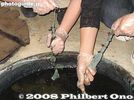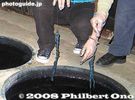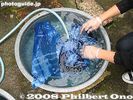 Image search results - "bunka" Image search results - "bunka" |

West gate (Nishi Gate) to Kibogaoka Culture Park, a large prefectural park featuring a large grassy lawn, sports facilities, camping facilities, and seminar facilities. MAP
|
|

Large grassy lawn.
|
|

Mt. Mikami in the distance.
|
|
|

Grass slide
|
|
|

Shallow stream
|
|

Mushrooms
|
|
|
|

Softball field
|
|

Cherry blossoms and softball field
|
|

West Gate for car parking. Bus stop on right.
|
|

Bin-temari in Echigawa, Shiga. Echigawa's bin-temari history goes back to around 1840 when its oldest bin-temari was made. However, this traditional art died out with the death of Aoki Hiro in 1973, Echigawa's last bin-temari maker.
|
|

After Aoki's death, a temari preservation society was formed and the craft was passed on based on Aoki's husband's memory of how his wife made it. Besides Echigawa, only a few other places in Japan still make bin-temari.
|
|

The ball is actually hollow like a balloon. It is inserted into the bottle in a deflated state, then expanded into a ball. The museum also has a fascinating video showing how temari is made.
|
|

Nagahama Bonbaiten exhibition of plum tree bonsai at Keiunkan. 長浜盆梅展
|
|

Konki Senshoku noren curtain. They've been in business in Konan for 200 years. One of three shops left in Shiga doing traditional indigo dyeing with natural (not synthetic) indigo dye. MAPTake a bus or taxi from Kosei or Mikumo Stations on the Kusatsu Line. Get off at Shimoda and walk 50 meters. Parking also available. Phone: 0748-75-0128, Address: Shimoda 1530, Konan-shi, Shiga
|
|

They grow their own indigo plants, dry the leaves in the sun, and extract the dye. They offer indigo dyeing lessons during which you can dye a cotton handkerchief for 1200 yen (T-shirts also). The kind lady first showed us samples of indigo fabrics.
|
|

Then we go to the indigo vats. They are heated with charcoal made with wood from trees on their hill. Each vat has a different indigo density.
|
|

We started with a vat having a low density of indigo. We dip the handkerchief for 15 sec., wring it, then expose it to the air. The indigo dye is actually a murky brownish-yellow color, but turns blue when exposed to the air.
|
|

We dipped the handkerchief in multiple vats, each successive vat had a higher density of indigo. The more vats we dip the fabric in, the darker the color.
|
|

After the indigo dip, water washed the handkerchief.
|
|

Toyako Culture Center with G8 Summit flags
|
|

Official logo of the G8 Hokkaido Toyako Summit on the Toyako Culture Center.
|
|

Biwako Bunka Park or Bunka Zone, featuring a Japanese garden, the Museum of Modern Art, and Shiga Prefectural Library.
|
|

Japanese garden pond with koi.
|
|
|
|
|
|
|

Japanese garden and Museum of Modern Art, Shiga.
|
|
|
|
|